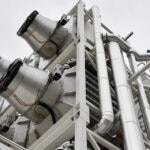Cleantech carbon capture: a key technology in the fight against climate change
Carbon capture is one of the most promising cleantech solutions for the fight against climate change. Companies like Heirloom are revolutionizing this sector with technologies capable of extracting up to 320,000 tons of carbon dioxide from the air every year.
Cover photo: EFE

Carbon capture and storage (CCS) has been discussed as a climate solution for decades. In recent years, however, it has evolved from a concept paper to a promising, actionable project. The latest report from the Intergovernmental Panel on Climate Change (IPCC) emphasizes that CCS solutions need to play a crucial role in combating climate change over the medium and long term.
The report acknowledges that significant challenges remain in the implementation of carbon capture facilities and large-scale storage solutions. However, it highlights that these technologies can be highly effective in decarbonizing industrial processes that currently depend on fossil fuels.
The Heirloom carbon capture system
In northwestern Louisiana (U.S.), Heirloom is building two large-scale carbon capture plants that extract carbon dioxide directly from the air. Once fully operational, these facilities will have the capacity to remove 320,000 tons of greenhouse gases from the atmosphere annually. The system they have developed replicates a natural process that occurs in limestone rocks, but accelerates it significantly - reducing the time it takes to transform back into rock from several years to just three days.
The Heirloom system also enables the carbon to be extracted from limestone rocks and converted back into lime to restart the process. Meanwhile, the extracted carbon is securely and stably stored underground, preventing it from returning to the atmosphere as carbon dioxide.
Beyond direct capture from the atmosphere, numerous solutions are being developed to trap carbon dioxide during industrial processes in factories. This capture can occur after combustion by extracting carbon dioxide from the waste gases generated by burning fossil fuels, or before combustion by converting fossil fuels into synthetic fuels and capturing the carbon dioxide before it is burned.
Carbon capture is the future
Carbon capture technologies are starting to play an essential role in the decarbonization plans of governments and companies. However, its massive adoption depends on overcoming major challenges, such as reducing costs, improving efficiency and creating regulatory frameworks that incentives its use. As investment in cleantech rises, the development of new solutions and large-scale carbon capture plants could accelerate the transition to a cleaner economy and significantly reduce global emissions.
Beyond mitigating the effects of climate change, carbon capture opens the door to new economic opportunities in sectors such as energy, industry and construction. Captured CO2 can be reused in products such as synthetic fuels, concrete, and advanced materials, creating a circular economic model around these technologies. In the coming years, the combination of technological innovation, investment and regulation will be critical in ensuring that carbon capture moves from an emerging solution to an essential tool to attain climate neutrality targets.
